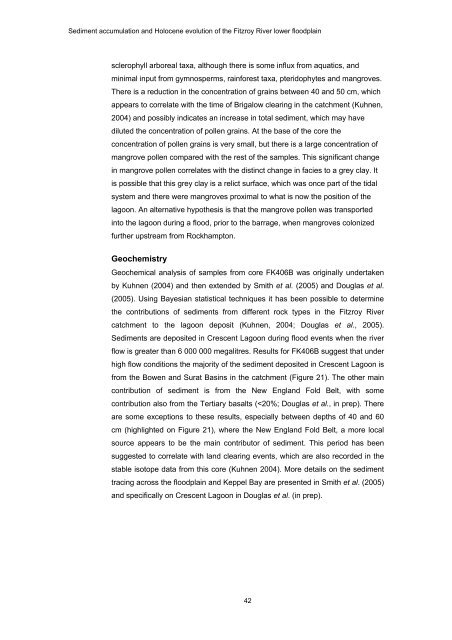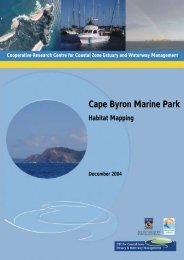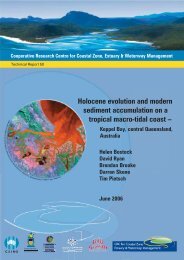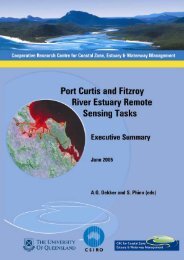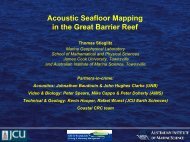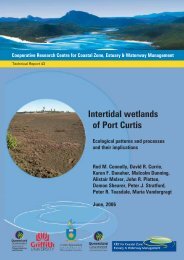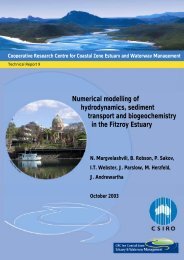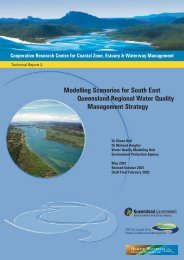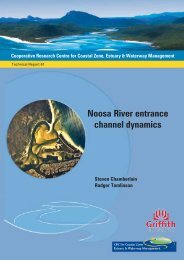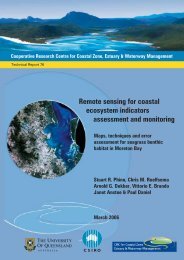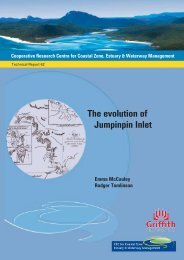Sediment accumulation and Holocene - OzCoasts
Sediment accumulation and Holocene - OzCoasts
Sediment accumulation and Holocene - OzCoasts
Create successful ePaper yourself
Turn your PDF publications into a flip-book with our unique Google optimized e-Paper software.
<strong>Sediment</strong> <strong>accumulation</strong> <strong>and</strong> <strong>Holocene</strong> evolution of the Fitzroy River lower floodplain<br />
sclerophyll arboreal taxa, although there is some influx from aquatics, <strong>and</strong><br />
minimal input from gymnosperms, rainforest taxa, pteridophytes <strong>and</strong> mangroves.<br />
There is a reduction in the concentration of grains between 40 <strong>and</strong> 50 cm, which<br />
appears to correlate with the time of Brigalow clearing in the catchment (Kuhnen,<br />
2004) <strong>and</strong> possibly indicates an increase in total sediment, which may have<br />
diluted the concentration of pollen grains. At the base of the core the<br />
concentration of pollen grains is very small, but there is a large concentration of<br />
mangrove pollen compared with the rest of the samples. This significant change<br />
in mangrove pollen correlates with the distinct change in facies to a grey clay. It<br />
is possible that this grey clay is a relict surface, which was once part of the tidal<br />
system <strong>and</strong> there were mangroves proximal to what is now the position of the<br />
lagoon. An alternative hypothesis is that the mangrove pollen was transported<br />
into the lagoon during a flood, prior to the barrage, when mangroves colonized<br />
further upstream from Rockhampton.<br />
Geochemistry<br />
Geochemical analysis of samples from core FK406B was originally undertaken<br />
by Kuhnen (2004) <strong>and</strong> then extended by Smith et al. (2005) <strong>and</strong> Douglas et al.<br />
(2005). Using Bayesian statistical techniques it has been possible to determine<br />
the contributions of sediments from different rock types in the Fitzroy River<br />
catchment to the lagoon deposit (Kuhnen, 2004; Douglas et al., 2005).<br />
<strong>Sediment</strong>s are deposited in Crescent Lagoon during flood events when the river<br />
flow is greater than 6 000 000 megalitres. Results for FK406B suggest that under<br />
high flow conditions the majority of the sediment deposited in Crescent Lagoon is<br />
from the Bowen <strong>and</strong> Surat Basins in the catchment (Figure 21). The other main<br />
contribution of sediment is from the New Engl<strong>and</strong> Fold Belt, with some<br />
contribution also from the Tertiary basalts (


